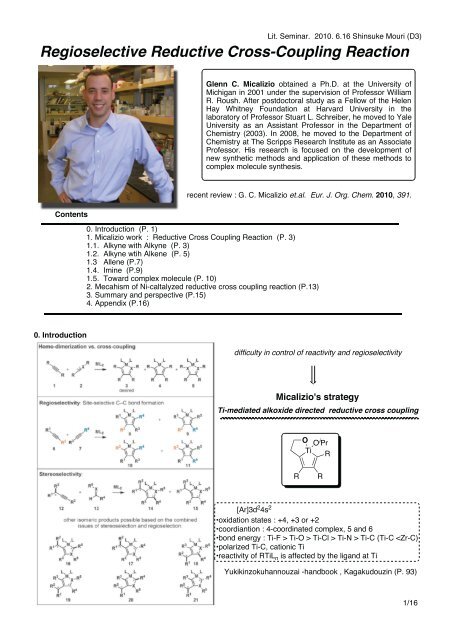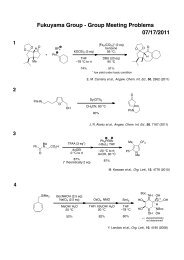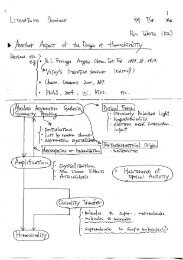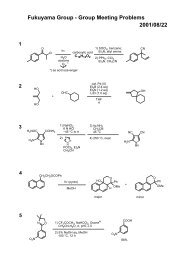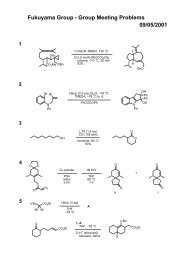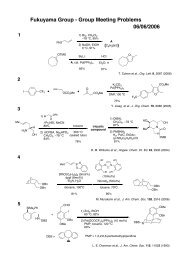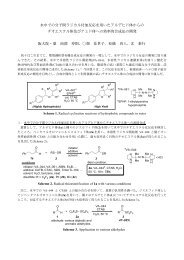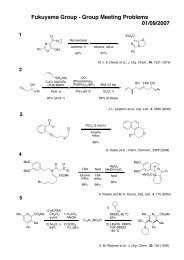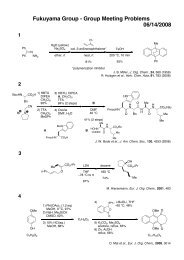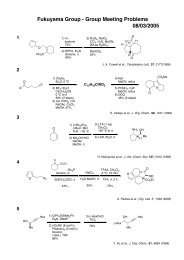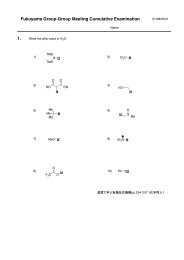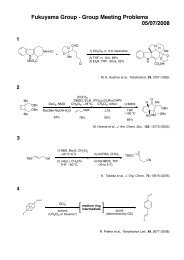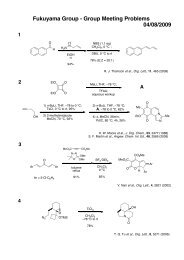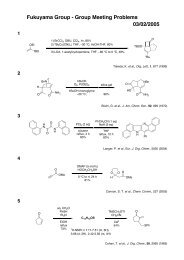Regioselective Reductive Cross-Coupling Reaction
Regioselective Reductive Cross-Coupling Reaction
Regioselective Reductive Cross-Coupling Reaction
Create successful ePaper yourself
Turn your PDF publications into a flip-book with our unique Google optimized e-Paper software.
Lit. Seminar. 2010. 6.16 Shinsuke Mouri (D3)<br />
<strong>Regioselective</strong> <strong>Reductive</strong> <strong>Cross</strong>-<strong>Coupling</strong> <strong>Reaction</strong><br />
Contents<br />
0. Introduction<br />
Glenn C. Micalizio obtained a Ph.D. at the University of<br />
Michigan in 2001 under the supervision of Professor William<br />
R. Roush. After postdoctoral study as a Fellow of the Helen<br />
Hay Whitney Foundation at Harvard University in the<br />
laboratory of Professor Stuart L. Schreiber, he moved to Yale<br />
University as an Assistant Professor in the Department of<br />
Chemistry (2003). In 2008, he moved to the Department of<br />
Chemistry at The Scripps Research Institute as an Associate<br />
Professor. His research is focused on the development of<br />
new synthetic methods and application of these methods to<br />
complex molecule synthesis.<br />
recent review : G. C. Micalizio et.al. Eur. J. Org. Chem. 2010, 391.<br />
0. Introduction (P. 1)<br />
1. Micalizio work : <strong>Reductive</strong> <strong>Cross</strong> <strong>Coupling</strong> <strong>Reaction</strong> (P. 3)<br />
1.1. Alkyne with Alkyne (P. 3)<br />
1.2. Alkyne wtih Alkene (P. 5)<br />
1.3 Allene (P.7)<br />
1.4. Imine (P.9)<br />
1.5. Toward complex molecule (P. 10)<br />
2. Mecahism of Ni-caltalyzed reductive cross coupling reaction (P.13)<br />
3. Summary and perspective (P.15)<br />
4. Appendix (P.16)<br />
difficulty in control of reactivity and regioselectivity<br />
Micalizio's strategy<br />
Ti-mediated alkoxide directed reductive cross coupling<br />
R<br />
O OiPr Ti<br />
R<br />
[Ar]3d 2 4s 2<br />
•oxidation states : +4, +3 or +2<br />
•coordiantion : 4-coordinated complex, 5 and 6<br />
•bond energy : Ti-F > Ti-O > Ti-Cl > Ti-N > Ti-C (Ti-C
Why did Micalizio focus attention on Ti-mediated strategy?<br />
1. The ability of Ti alkoxide to undergo rapid and reversible ligand exchange.<br />
paste<br />
mechanism of katsuki sharpless epoxidation in<br />
Strategic Applications of Named <strong>Reaction</strong>s in Organic Chemistry (Kagakudouzin)<br />
2. Cp 2 Ti-π complex are known to participate reductive cross coupling.<br />
Sharpless et. al. J. Am. Chem. Soc. 1991, 113, 106.<br />
Katuski T. et. al. Org. React. 1996 ,48, 1.<br />
Bercaw et. al. J. Am. Chem. Soc. 1983, 105, 1136.<br />
Sato. et. al Chem. Rev. 2000, 100, 2835<br />
3. Ti alkoxide could be employed to acess similar reactivity seen with Cp2Ti-π comples (Kulinkovich, Sato)<br />
Kulinkovich et. al. Zh. Org. Khim. 1989, 25, 2244.<br />
the cost of stoichiometric Ti(OiPr) 4 is significantly less than known catalytic systems based on Ni, Rh, Ir or Ru.<br />
2/16
Alkyne + Alkyne<br />
Class I<br />
26 28 27<br />
Micalizio et. al. J. Org. Chem. 2009, 74, 7211.<br />
•O-protected alkyne gave products with moderate rr.<br />
3/16
Class II<br />
Micalizio et. al. J.Am. Chem. Soc .2006 128, 2764.<br />
Substrate scope is limited based on<br />
factors influencing reactivity and resioselectivity.<br />
R 1<br />
Ti(O i Pr) 4<br />
R 2<br />
-78 ºC to -50 ºC<br />
2 h<br />
i PrMgCl<br />
R 1<br />
R 2<br />
Ti(O i Pr) 2<br />
Sato, F. et. al.<br />
Tetrahedron Lett. 1995, 36, 3203.<br />
Ti(O i Pr) 2<br />
Ti(O i Pr) 2<br />
D 2O<br />
R 1<br />
R 2<br />
D<br />
D<br />
up to 100%<br />
Z :E = >99: 1<br />
the tetherd alkoxide plays a central role<br />
in determing regio selection. Jin Kun Cha et. al. J. Am. Chem. Soc. 1996, 118, 4198. 4/16
1.2 Alkyne with Alkene Micalizio et. al. Angew Chem. 2007. 119, 1462.<br />
Micalizio et. al. J. Am. Chem. Soc. 2007, 129, 15112.<br />
allylic alcohol case<br />
OH<br />
+<br />
OPMB<br />
PMBO<br />
65%<br />
PMBO<br />
OPMB<br />
alkyne (1.0 equiv), ClTi(Oi-Pr) 3, PhMe, C 5H 9MgCl, -78 to -35 ºC,<br />
then recool to -78 ºC add Li-alkoxide of allylic alcohol (1.0 equiv)<br />
(-78 to 0 ºC).<br />
• via formal [3,3]-rearrangement route<br />
5/16
6/16
1.3 Allen<br />
1.3.1 allene+ alkyne<br />
Micalizio et. al. Chem. Commun. 2007, 4531.<br />
OH<br />
Me<br />
•<br />
+<br />
OPMB<br />
PMBO<br />
OH<br />
Me<br />
74%<br />
OPMB<br />
OPMB<br />
alkyne (1.4 eq.), Ti(O i -Pr) 4 (2.1 eq.), c-C 5H 9MgCl (4.2 eq.),<br />
PhMe (-78 ºC to -30 ºC), cool to -78 ºC then add allenyl<br />
alkoxide (1 eq.), (-78 ºC to 0 ºC).<br />
1.3.2 allene+ imine<br />
iPr OH + Cl<br />
•<br />
Micalizio et. al. Synlett, 2008, 735.<br />
nPr N<br />
Cl<br />
n Pr<br />
NH<br />
iPr 63%, E/Z = >20:1<br />
Typical reaction conditions: imine (1.0 equiv), ClTi(Oi-Pr) 3<br />
(1.25 equiv), c-C 5H 9MgCl (2.5 equiv), Et 2O (-78 ºC to -40<br />
ºC), then add allenyl alkoxide (3-4 equiv, -40 ºC to 0 ºC).<br />
Micalizio et. al. Tetrahedron 2008, 68, 3437.<br />
7/16
8/16
1.4. Imine<br />
(Micalizio et.al. Angew. Chem. Int. Ed. 2007, 46, 391.) aza-Pauson Khand-like annulation reaction for the<br />
synthesis of tetrasubstituted γ-lactams<br />
(Micalizio et.al. Chem Commun. 2010, 46, 3336.)<br />
carbometalation process is irreversible.<br />
9/16
Toward complex molecule<br />
Micalizio et. al. J. Am. Chem .Soc. 2008, 130, 16870<br />
ca. 50%<br />
a) MeC(MgBr)CH 2 , MeC(OMe) 3, EtCOOH (cat), reflux<br />
(Micalizio et.al. J. Am. Chem. Soc. 2009, 48, 3648.)<br />
(d) Imine (2.0 equiv), Ti(O i -Pr) 4 (3.0 equiv),<br />
c-C 5H 9MgCl (6.0 equiv), 8 (1 equiv), Et 2O.<br />
(b) HCl(aq), THF.<br />
•This empirical model does not yet address the number of<br />
ligands presenton the metal center in the transition state.<br />
•Others have suggested ate complexes as reactive<br />
intermediates in the Kulinkovich reaction.<br />
O<br />
R OR<br />
+ Ti(O i Pr) 4<br />
n PrMgBr<br />
Ti (Oi -<br />
Pr) 4<br />
R OR<br />
octahedral ate complex<br />
Kulinkovich et. al. Eur. J. Org. Chem. 2007, 2121.<br />
O<br />
10/16
Micalizo et. al. Nat. Chem. DOI: 10.1038/NCHEM.665<br />
1)<strong>Reaction</strong> conditions for cross-coupling: vinylsilane, ClTi(Oi-Pr) 3, c-C 5H 9MgCl, Et 2O (-78 to -50 ºC), then add lithium alkoxide of<br />
vinylcyclopropane(–70 ºC to roomtemperature over 3 h). Oxidation conditions: TBHP, H 2O, CsOH.H 2O, TBAF, DMF, 70 ºC.<br />
2)Oxidation conditions: KF, KHCO 3, H 2O 2, MeOH, THF. CH 2Cl 2, Sm[Hg], THF, (85%, dr= 20:1). PDC, 4-Å molecular sieves,<br />
CH 2Cl 2 (91%), then L-Selectride, THF (76% of desired isomer, dr=6:1).<br />
11/16
(a)ClTi(Oi-Pr) 3, c-C 5H 9MgCl, 35 (-78 to 30 ºC), PhMe, then lithium alkoxide of 34 in Et 2O (-70 ºC to room<br />
temperature over 3 h)<br />
(b)TBAF, THF<br />
(c)ClTi(Oi-Pr) 3, c-C5H9MgCl, alkyne (-78 to -30 ºC), PhMe, then lithium alkoxide of the vinylcyclopropane in Et 2O<br />
(-70 ºC to room temperature over 3 h);<br />
(d) HF.pyr, CH 3CN, CH 2Cl 2;<br />
(e) PDC, DMF, H2O.<br />
Yields reported are over the three-step sequence (c-e) and are adjusted based on the quantity of recovered<br />
starting material (vinylcyclopropane). Isolated yields for each reaction sequence are 38% (equation (2)), 36%<br />
(equation (3)) and 23% (equation (4)) over the three-step process (corresponding to average yields of 60-70% per<br />
step).<br />
Micalizio et. al. J. Am. Chem. Soc. 2009, 131, 1392.<br />
O<br />
OH<br />
total synthesis<br />
OH<br />
Me Me Me<br />
OAc<br />
Phorbasin C<br />
Me<br />
Micalizio et. al. Angew. Chem. Int. Ed. 2008, 47, 4005.<br />
MeO<br />
Me<br />
H<br />
H<br />
Me<br />
O<br />
NH 2<br />
OMe<br />
Me<br />
H<br />
O<br />
H<br />
N<br />
OMe<br />
O<br />
Me<br />
O<br />
H<br />
O<br />
Macbecin I<br />
Me<br />
12/16
2. Mechanism of Ni-catalyzed reductive cross coupling reaction<br />
R 1 R 2 +<br />
H<br />
O<br />
R 3<br />
+ BEt 3<br />
Ni(0) catalyst<br />
H + /H 2O<br />
J. Montgomery et. al.<br />
J. Am. Chem. Soc. 2007, 129, 9568.<br />
J. Krische et. al.<br />
J. Am. Chem. Soc. 2007, 129, 8432.<br />
F. Jamison, et. al.<br />
J. Am. Chem. Soc. 2004, 126, 15342.<br />
R 1<br />
R 2<br />
OBEt 2<br />
Jamison and Houk et. al. J. Am. Chem. Soc. 2009, 131, 6654<br />
(a) oxidative cyclization of alkyne and aldehyde to form a metallacycle intermediate, followed by<br />
transmetalation of the reductant and subsequent reductive elimination of the product<br />
(b) a similar mechanism but with the metal bonded to the reductant in the oxidative cyclization<br />
(c) oxidative addition of the reductant to the metal and subsequent insertion of the two π components<br />
(d) oxidative addition to one π component (alkyne or aldehyde) and subsequent insertion of the second<br />
component.<br />
R 3<br />
13/16
R 1<br />
3<br />
R 1<br />
R 2<br />
L<br />
Ni<br />
L<br />
L<br />
Ni<br />
R 2<br />
4 H<br />
R 1<br />
O<br />
R 3<br />
R 2<br />
11<br />
OBEt 2<br />
R 3<br />
acetylene<br />
oxidative<br />
cyclization<br />
TS1-A<br />
Path A<br />
R 1<br />
5<br />
+<br />
R 2<br />
R 1<br />
L<br />
Ni<br />
1<br />
H<br />
R 2<br />
O<br />
R 3<br />
+<br />
R 1<br />
BEt 3<br />
H<br />
O<br />
2<br />
R 2<br />
L<br />
Ni<br />
6<br />
Path B<br />
R 3<br />
O<br />
R 3<br />
R 1<br />
ethylene<br />
BEt 3<br />
R 2<br />
oxidative<br />
cyclization<br />
TB1-B<br />
L<br />
Ni<br />
H<br />
7<br />
O<br />
R 3<br />
R 1<br />
R 1<br />
BEt 3<br />
R 2<br />
L<br />
Ni<br />
L<br />
Ni<br />
8<br />
O<br />
R 3<br />
BEt 3<br />
R 1<br />
R OBEt<br />
10 2<br />
2<br />
R3 L Et<br />
Ni<br />
O<br />
R 2<br />
9<br />
transmetalation<br />
(alkyl migration)<br />
TS2<br />
R 3<br />
BHEt 2<br />
β-hydrogen<br />
elimination and<br />
reductive<br />
elimination<br />
TS3<br />
14/16
3. Summary and Perspective<br />
Micalizio demonstrated new type of reductive cross coupling based on the Ti mediated alkoxide directed<br />
strategy. This system is applicable to many type of reductive cross coupling and also Micalizio is also<br />
successful in to complex molecule. Further if possible....<br />
1) catalytic<br />
2) mechanism - ligand number and effect on Ti (transition state )<br />
(Micalizio et.al. Angew. Chem. Int. Ed. 2009, 48, 3648.)<br />
15/16
4. Appendix<br />
Jamison and Houk et. al. J. Am. Chem. Soc. 2010, 132, 2050.<br />
16/16


